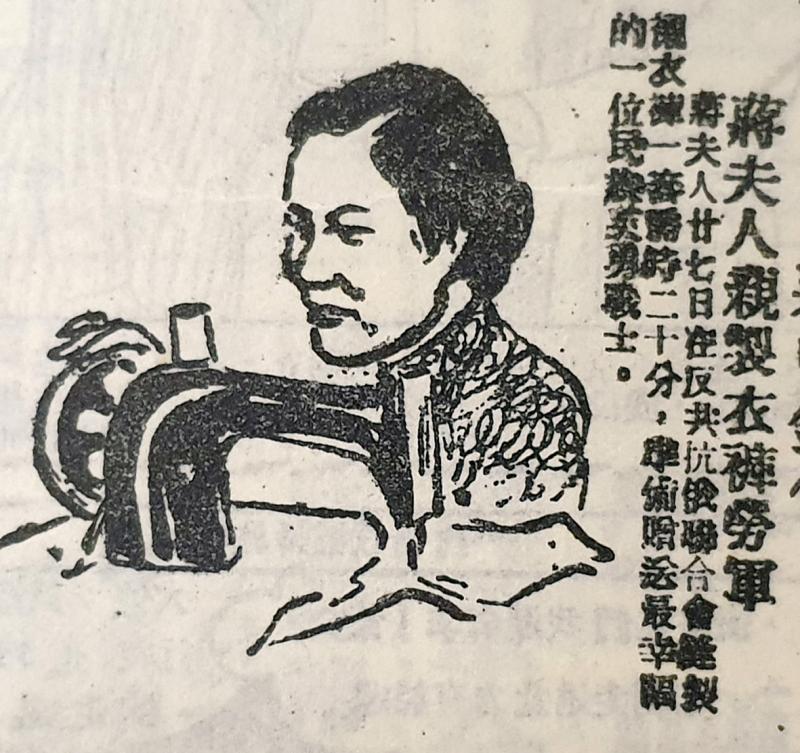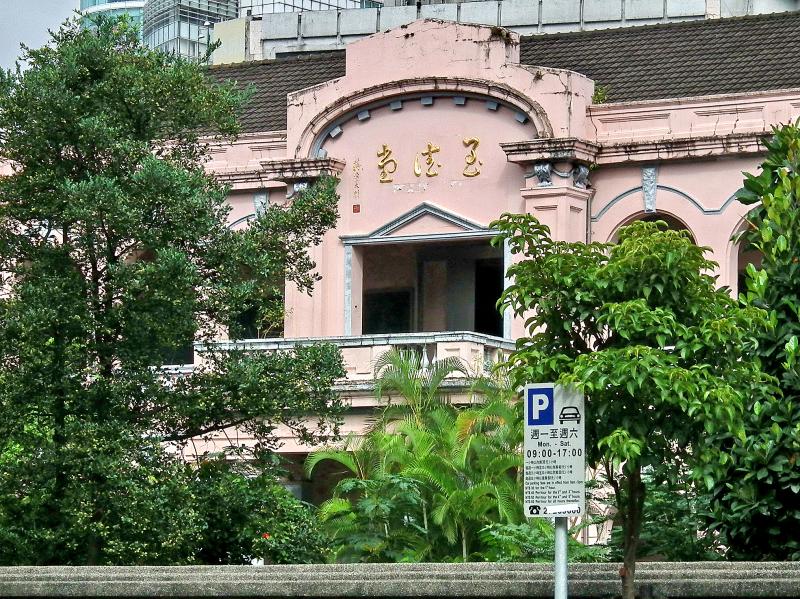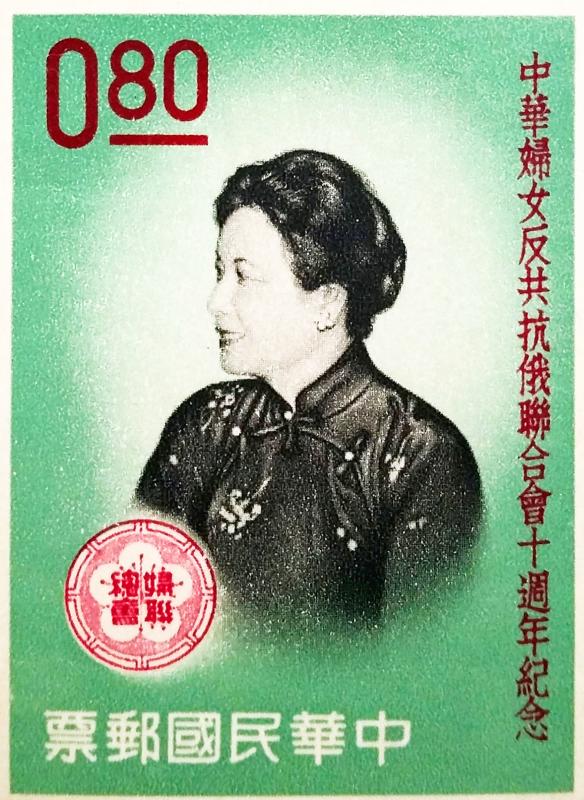May 4 to May 10
The image of then-first lady Soong Mayling (宋美齡) personally sewing clothes for military personnel embodied the spirit of the National Women’s League’s early days.
While it was mostly known as a charity group before its dissolution on Monday, the league took on quite a different character in its early days when it was known as the Chinese Women’s Anti-Communist and Anti-Soviet League (中華婦女反共抗俄聯合會).

Photo courtesy of National Central Library
Soong founded the league in 1950 to assist the war effort by providing aid to soldiers and their families. Through activities such as entertaining troops and building military dependent villages, it rallied the patriotism of its members and also reinforced Soong’s image as the nation’s benevolent mother who stood by her husband Chiang Kai-shek (蔣介石).
This was before the fight for female empowerment took off in the 1970s, and this early “women’s movement” focused on contributing their expertise to the war. Dating back to his days battling the northern warlords in China in the 1920s, Chiang often stressed that both men and women were responsible for the survival of the nation, and the league was a way to implement the notion.
“If society ignored the power of women, we would lose half our fighting force,” the league’s mouthpiece China’s Women (中華婦女) stated in its first issue. “We should know that every person is responsible for the rise and fall of a country … Saving one’s nation has nothing to do with gender or age. Today, we women must mobilize under our great leader Madame Chiang and the flag of anti-communism ... to maintain world peace and defend democracy and freedom.”

Photo courtesy of Wikimedia Commons
SETTING THE SCENE
Soong was in the US when the Chinese Nationalist Party (KMT) retreated to Taiwan in 1949. She arrived in Taipei on Jan. 13, 1950, and just eight days later she attended her first public event when she visited wounded soldiers at a hospital. She was accompanied by a group of about 40 women consisting of the wives of government officials, female legislators and national assembly members.
Prominent women from across the nation threw Soong a welcome party at Taipei’s Zhongshan Hall on Jan. 24, where she detailed the three major roles of women in the fight against the Communists and Soviets: supporting the military, living frugally and rallying patriotism toward the motherland.

Photo courtesy of Chunghwa Post
During the event, Soong asked attendees to donate money to buy 300 prosthetic limbs for the soldiers she saw in the hospital. Most of them were wounded while fighting the People’s Liberation Army on the islands of Kinmen and Dengbu (登步) off the Chinese coast. According to the Central Daily News (中央日報), she raised enough for 330 limbs.
Over the next two months, Soong traveled extensively, visiting wounded soldiers and meeting with prominent women across Taiwan as well as Kinmen. On March 1, 1950, Chiang Kai-shek resumed his position as president, and a huge rally was held in front of the Presidential Office, solidifying the image of Chiang as the revered leader who would carry out the sacred task of defeating the communists.
As the First Lady, Soong would be in charge of uniting the nation’s women to support the mission. Her rhetoric was very similar to Chiang’s — fiercely anti-communist with the ultimate goal of retaking China.
“Since my return, the communist bandits have colluded with the Soviets and betrayed the motherland,” she wrote in an article titled “The important mission of Chinese women today” (今日中華婦女的重要使命).
“I’ve deeply realized that the survival of our people is down to the wire, and we cannot wait any longer to mobilize the women in the nation. I have launched the Chinese Women’s Anti-Communist and Anti-Soviet League so we can use our strength in numbers to assist our military in retaking the mainland. In the past month or so, women from all walks of life have been eager to participate, and that makes me extremely excited and happy,” Soong wrote.
MILITARY SUPPORT
The league was formally established on April 17, 1950. In the closing ceremony, Soong confirmed that its main goal would be to serve the nation’s military personnel and their families, and she would reiterate the mission in future speeches and interviews.
“As our soldiers fight on the frontlines, their families in Taiwan are also suffering … I hope that the league especially cares for their spouses who are scattered across every city and town … and help them live stable lives so their husbands on the frontlines don’t have to worry while defending the country,” Chiang implored during the league’s sixth anniversary event in 1956.
One of their first tasks was to raise funds to make clothing items for the soldiers in mini-factories above their offices. Over 1.5 million women participated over 40 years — from politicians to factory workers to students to celebrities — and produced more than 10 million items.
The propaganda component was clear — a poem written by an anonymous soldier published in the Central Daily News praised the hard-working and patriotic women who sewed his clothes “needle by needle with the same hatred toward the enemy,” concluding that he would never take the shirt off unless he vanquished the Chinese Communists and toppled the Soviet Union.
Aside from sending goods and money to the soldiers and providing entertainment to the wounded in the hospital and those on the frontlines in Kinmen and Matsu, the league also raised funds to build over 50,000 houses for military dependents between 1957 and 1992, as well as schools, an orphanage and a home for polio patients.
After the lifting of martial law in 1987, the league expanded its services to others in need. By 1996, it had shed its anti-communist label and became simply known as the National Women’s League.
Taiwan in Time, a column about Taiwan’s history that is published every Sunday, spotlights important or interesting events around the nation that have anniversaries this week.

On April 26, The Lancet published a letter from two doctors at Taichung-based China Medical University Hospital (CMUH) warning that “Taiwan’s Health Care System is on the Brink of Collapse.” The authors said that “Years of policy inaction and mismanagement of resources have led to the National Health Insurance system operating under unsustainable conditions.” The pushback was immediate. Errors in the paper were quickly identified and publicized, to discredit the authors (the hospital apologized). CNA reported that CMUH said the letter described Taiwan in 2021 as having 62 nurses per 10,000 people, when the correct number was 78 nurses per 10,000

As we live longer, our risk of cognitive impairment is increasing. How can we delay the onset of symptoms? Do we have to give up every indulgence or can small changes make a difference? We asked neurologists for tips on how to keep our brains healthy for life. TAKE CARE OF YOUR HEALTH “All of the sensible things that apply to bodily health apply to brain health,” says Suzanne O’Sullivan, a consultant in neurology at the National Hospital for Neurology and Neurosurgery in London, and the author of The Age of Diagnosis. “When you’re 20, you can get away with absolute

May 5 to May 11 What started out as friction between Taiwanese students at Taichung First High School and a Japanese head cook escalated dramatically over the first two weeks of May 1927. It began on April 30 when the cook’s wife knew that lotus starch used in that night’s dinner had rat feces in it, but failed to inform staff until the meal was already prepared. The students believed that her silence was intentional, and filed a complaint. The school’s Japanese administrators sided with the cook’s family, dismissing the students as troublemakers and clamping down on their freedoms — with

As Donald Trump’s executive order in March led to the shuttering of Voice of America (VOA) — the global broadcaster whose roots date back to the fight against Nazi propaganda — he quickly attracted support from figures not used to aligning themselves with any US administration. Trump had ordered the US Agency for Global Media, the federal agency that funds VOA and other groups promoting independent journalism overseas, to be “eliminated to the maximum extent consistent with applicable law.” The decision suddenly halted programming in 49 languages to more than 425 million people. In Moscow, Margarita Simonyan, the hardline editor-in-chief of the